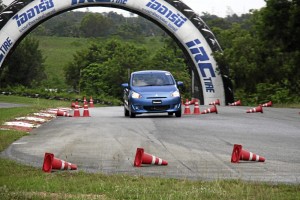Mitsubishi’s dominance in the local motoring market has also highlighted the chink in its armor: the lack of a small passenger car that will complement its strong SUV and pick-up range. Thankfully, the stars have aligned and Mitsubishi Motors Corp. has launched their global small car project, now known as the Mirage.
The Mirage is an old nameplate that hasn’t been used in the local market for almost three decades. Thankfully the new one was worth the wait.
The Mirage is an all-new hatchback built in Mitsubishi’s Laem Chabang port city facility in Thailand. An all-new factory expansion, called Plant No. 3, was put up to answer the forecast of more than 100,000 units for fiscal year 2012, producing both LHD and RHD Mirages to be exported to Asean, Africa, Australia, South America and Europe.
Let’s get the nit-picking out first. Outside, it looks like a Lancer sedan that’s been prematurely hatched while still in its embryonic stage. The back end looks quite a bit better in this respect. The Mirage’s interior is okay as small cars go, and with its projected SRP of between P500,000 and P600,000 for the four variants coming in, but on its own, the plastics feel low-rent and could use more soft-touch materials. Some bright silver and shiny black piano wood trim helps liven up what could have been a taxi-spec interior. The switchgear is all-new and modern, with a/c vents having a hint of Chevrolet Camaro in them. The speedometer dominates the instrument cluster with the tachometer on the left, and fuel level and other information displayed to the right.
The rear cargo space is deep, allowing tall objects to be safely secured. It’s the biggest cargo space in its class according to Mitsubishi engineers. I can easily fit two medium-sized travel bags standing up. If you need more space, drop the 65:35 split-folding seats to open up the rest of the interior for more cargo space. The seats are comfortable and supportive, and the 65:35 spit-folding back seats are surprisingly very roomy for a sub 6-foot journalist with a 42-inch waistline and 220-lb++ frame. Credit goes to an almost flat floor and quite tall-mounted front seats that allow my size 11 EEE’s to slide underneath them, providing good foot, knee and overall legroom. Sadly, the raised front seats, which help give more foot-room is a double-edged sword as drivers sit high up; it could have been made a bit lower to improve driving feel. The 3-spoke steering wheel could also use a bit more adjustment, again to improve driving position, feel and feedback.
The variants we tried out at the Bira International Circuit near Pattaya were equipped with a single driver’s airbag and ABS-EBD brakes on small and narrow 14-inch wheels equipped with 165/60 R14 all-season Yokohama tires. OEM 15-inch wheels will be available on higher end variants once they arrive in the Philippines.
The powertrain is an all-new 3-cylinder engine code-named 3A92 that features 12 valves and DOHC MIVEC engine to help make the most out of the modest 78 PS and 100 Newton-Meters of torque. Attached is a 5-speed manual transmission with a very light and positive feeling clutch, or Mitsubishi’s INVECS-III CVT transmission, which features both a normal mode and sport mode that simulates a 6-speed transmission for more aggressive driving.
On-track histrionics are not the Mirage’s strongest suit, so consumers will be pleased to know that Mitsubishi’s own tests have produced a highly believable 22 km/liter fuel consumption on combined city and highway driving. Methinks a 10-12, possibly even a 14 km/liter fuel consumption is attainable in purely city driving in our traffic-laden metropolis.
Despite some foibles, Mitsubishi has a winner here: a surprisingly roomy interior, decent poke from the engine, great fuel economy. If they can get the pricing down to well below P600,000 by the fourth quarter of 2012, I can’t see why this won’t be Mitsubishi’s latest success story.
